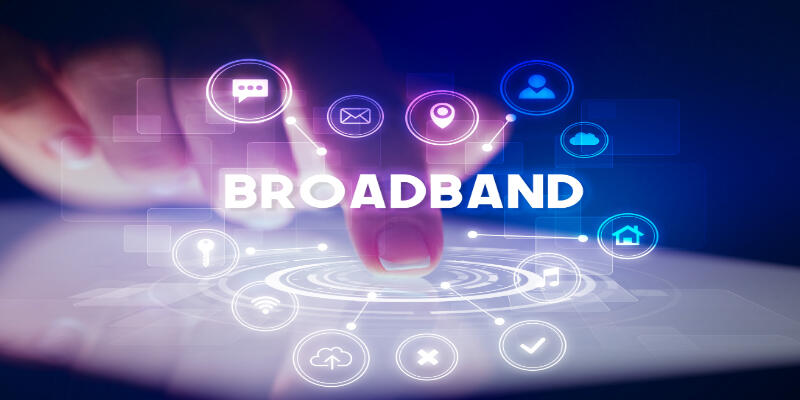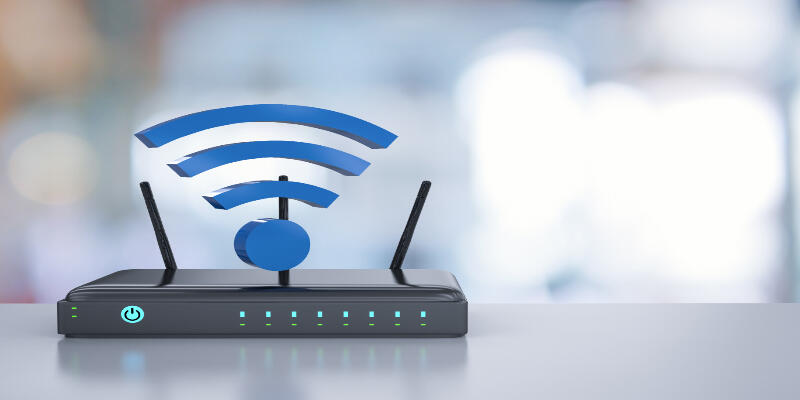Disclaimer: This post may contain affiliate links, meaning we get a small commission if you make a purchase through our links, at no cost to you. For more information, please visit our Disclaimer Page.
Broadband connection has replaced dial-up and has become the most used type today. Consumer needs are changing, even in internet connections. More and more people are striving for a faster connection to make their internet experience better. Fast Internet connection is important for businesses, especially start-ups.
To check if you have a broadband connection, look at your equipment and cable type. Each type of internet connection uses a different cable. You can also know based on speed, and for broadband, it is an average of 25 Mbps / 3 Mbps. Another way is to check it with your ISP.
Broadband internet also helps people from rural areas access information. It changes the way information flow and offers users high-quality internet services. Broadband is present in education, healthcare, corporations, and many households.
You have come to the right place to learn how to check whether you have broadband, types of connections and what are its benefits.
Table of Contents
Do I Have Broadband Internet: How to Check?
The first thing you should do to check your Internet speed by doing a Speed Test. For broadband internet, there is a specified minimum download speed of 25 Mbps and a minimum upload speed of 3 Mbps.
However, this speed is changing, meaning that 11 Mbps internet is also good broadband internet. It all depends on your needs and for which package you are ready to pay. Some broadband internet connections have a speed of 1000 Mbps and more.
Previously the specified speed for broadband internet was 4 Mbps/1 Mbps. However, the Federal Communications Commission changed it in 2010 because the market and behavior of consumers have been developing.
They claimed that households now have different needs, and there are sometimes two-way communications at the same. All of that requires fast internet. The speed of 25 Mbps is minimal and enough to meet the demands of users. Many will pay for 25 Mbps or even 50 Mbps, but anything above that is a rare situation.
There are a variety of speed tests online, and even some internet providers have their speed tests. It will provide you with real-time information.
Another way to check whether you have broadband internet is to talk to your internet provider. You can also check your papers and bills and check the details about the service you are receiving from your ISP.
Before accepting any offer, go into details. Tell your provider what exactly you need and for what service you want to pay. You do not want to get extra Mbps that you will not even use. Also, you can always call customer service and find out any information.
You can also look at the back of your computer and see which cable is there. There is usually a telephone cable for older internet service. If you have broadband internet, you will notice a telephone connecting your device to another box or wall telephone jack.
Cables should look like television cables, which means you have fiber broadband. Always read content on the box, there should write whether you have broadband internet.
Have a look at Network and Internet in Control Panel on your computer. Then, find network and Sharing Center and click on your Wi-Fi name. It will show you the speed on the Wi-Fi status menu, which shows the connection between your computer and router.
What is Considered Broadband Internet?
As said before, every internet connection that has a minimum speed of 25 Mbps and a minimum upload speed of 3 Mbps is broadband internet.
Broadband is a term for high-speed internet that allows transferring the data over greater speeds. There are different technologies that broadband uses, such as fiber optic, DSL, satellite, wireless, and cable.
Fiber optic Internet can reach internet speed up to 340 Mpbs with low or no lags.
It can send data via cables that are high-quality, not prone to weather conditions, which makes them better than traditional cables that are usually fragile. For electrical interference, fiber cables can handle it effectively. This is ideal for households with many users.
Wireless broadband internet is what we usually have at home. It uses radio signals instead of cables to establish the connection between your home and the internet. You can connect all devices in your home without running a cable to your computer.
Wireless broadband gives you more freedom and makes everything easier. Mobility and the absence of cables are a significant advantage of a wireless network.
However, the connection may be slower and there is a possibility of interference because of other wireless devices.
DSL or Digital Subscriber Line uses traditional copper telephone lines that you already have in your house to transmit data. It is the most popular connection around the world.
Although it can provide you with fast speed, it also depends on the distance between you and your ISP. Some claim DSL is outdated because some fresh high-speed connection took over.
Cable is also a broadband internet that your TV provided provide to you. It uses the same coaxial cable television has. The speed of this internet depends on the number of users. The more the users, the slower the internet.
The slowest type of broadband internet is surely satellite. The installation of it costs much but monthly charges are reasonable. It is the best option for rural areas because it replaces dial-up.
Using this internet, your computer can multitask without interrupting your surfing on the web. It uses satellites to deliver internet connectivity. You can expect a download speed of 50 Kbps and an upload speed of 80 Kbps.
Whatever technology you opt for, keep in mind whether you live in the urban or rural areas. Also, consider the packaging of broadband internet with other services (for example telephone), availability, and price.
Are Broadband and Internet the Same Thing?
People have rarely or never thought about internet terms. Some things may be similar or the same, but in fact, they are not. This is same case with broadband and the internet.
Nowadays, people rely heavily on the internet, using it for different purposes from personal to business. Any business that wishes to start or grow must have a reliable and stable internet connection.
Because of that, it is important to know internet terminology to know and choose something for your different needs. So let’s learn more about it so it does not confuse you.
The internet incorporates hardware, software, computers, and various machines whose job it is to connect devices around the world. The term World Wide Web or WWW perfectly describes this.
This network of computers and servers are continuously communicating with each other to make it possible for people to visit different websites. There are many rules related to the behavior of servers so that they can run efficiently and successfully.
Internet is out of users’ control. They only pay for services and hope for the best.
On the other hand, broadband is a type of connection or technology for connecting users to the internet. Broadband is the first step when you want to visit any website on the internet. In that way, you can access billions of destinations on the internet. It acts as a tunnel for data to move to and from your home.
It is a shared network, so users in an area share a common larger connection. The amount of bandwidth in broadband connection depends on the package you pay for. ISP’s network traffic determines the speed and can vary from location to location.
Broadband uses two types of cables and those are fiber optic cable and copper cable.
Fiber optic cables are useful as they allow more bandwidth that carries a greater amount of data. It also includes faster speeds that every user strives for.
Copper cable transfer data with slower speeds. In the past, people used it to connect telephones. When copper cables arrived, they became widely popular as people wanted fresh ways to carry electronic data.
Broadband runs to your home thanks to technology from the fiber cabinet that includes loads of wires that connect to different parts on the Internet. For you to have a connection in your home, broadband connects to your router.
Another way for you to connect to the internet is using an Ethernet cable that goes into your router and computer. It also provides you with a fast connection, and people usually have it in their homes. Ethernet cable is not the same as broadband; it is just part of it.
Now that you have learned that the Internet and broadband are not the same thing, let’s touch upon recognizing the type of Internet connection you have.
How Do I Know What Type of Internet Connection I Have?
Your internet connection type can be determined best by looking at the equipment you have. As stated before, different broadband uses different cables and have different speeds.
I recommend you take some time and carefully examine your equipment. Look at wires on your modem and router, or their marks, because manufacturers sometimes write a type of internet connection on them.
When you have a satellite on your roof that controls your internet, you are dealing with a satellite connection. Also, if you live in rural areas, then it is more likely you have this type of connection.
Pay attention to plugs on the wall. If coaxial cable connects your modem and plug, then you have a cable internet connection. You will notice cable internet is slower during peak hours. It is also possible this cable connects to the satellite outside.
When you have DSL or dial-up, your cable connected to the modem looks like a phone line. Sometimes, your internet ties up your phone line and you cannot make or receive a phone call. It means you have dial-up internet. DSL connection does not interfere with your phone.
Fiber optic is recognizable because of the “ONT” or Optical Network Termination label on a modem. If you have that type of connection, you are lucky because it is the most reliable connection.
You will recognize a fixed wireless connection if you have a modem connected directly into an electrical outlet.
You cannot determine which type of internet connection you have without seeing your equipment thoroughly. However, as stated at the beginning, you can check the speed of your internet and guess which type of internet connection you have.
Sometimes the speed can tell you exactly what you have, but sometimes it can mean something else.
Dial-up internet has a speed of 65 kbit/s, DSL, cable, and fixed wireless have a speed of 100 Mbps, and cable and fiber optic internet have the result of 200-1000 Mbps.
Each of these types of connections meets various demands. A cable internet connection is for people who love streaming music and games. It provides them with good stability and speed.
Dial-up is for users who usually check their e-mails, social media, and news. It is budget-friendly and optimal for people who do not have big browsing habits.
Moderate users who love gaming and streaming mostly use DSL internet. Add to it the fastest speeds available, and you will get a fiber-optic connection, meant for people who enjoy streaming, gaming, and downloading large files.
Satellite internet is mostly for moderate users who enjoy movies and music. Last but not least is a fixed wireless connection for moderate users. It reaches the area where other types may not and is perfect for smaller households.
I have explained above that you can check for your broadband on your computer. You can find any information in Network and Sharing Center. If you do not see Ethernet or Wi-Fi labels in connections, it means you have dial-up.
If you have your modem connected to Ethernet, you will see a network cable. Wi-Fi connection is easily recognizable for its router and flashing green lights on it.
All these connections have different speeds or bandwidths. This depends mostly on your ISP and your device’s capabilities. With fast speeds, you can send more data quickly, share pictures and play games.
Faster speeds allow websites to load and open faster. Before you choose the type of internet connection, talk to your ISP to choose the best option for yourself.
Advantages and Disadvantages of Broadband Connection
Some people wait a couple of hours to download larger documents. Because of this, many people switched to faster broadband or DSL to prevent this from happening.
Broadband is available in lots of places, and if you have not upgraded your connection yet, let’s look at some advantages and disadvantages of broadband connection and decide whether you want to choose it for yourself.
There are many benefits of broadband connection, and the most important one is high speed. It is way too faster than a dial-up connection. For playing games, it is the best choice, because it improves performance.
Also, you can download large files, stream games, watch movies and upload whatever you want in minutes, thanks to its great bandwidth. Many users find it annoying when their computer cannot multitask with several applications, and broadband makes it possible!
Another great thing is that broadband connection does not affect your phone line, meaning you will not occupy your phone line while you are surfing the net.
Whether you use the internet via cable or phone line for fax or data transmission, you will be good. You will not need a traditional phone line, because there are many internet phone services available.
Unlike a dial-up connectivity route, you will not have to wait for connectivity with a broadband connection, because it is always on. In that way, you can be more productive and do more without waiting for pages to load.
Also, you will not waste your time entering your username and password when you start up your device.
A broadband connection is more reliable than others. You notice may that weather affects dial-up connection, and sometimes users cannot access their internet because of it.
With a broadband connection, you will not come across these problems, and you will always have your internet connection no matter the conditions.
By using a broadband connection, you can share internet connections among multiple PCs and other devices. Broadband routers are usually wireless, which are useful for game consoles, mobile phones, and tablets.
Many households have a lot of family members that have different devices and needs. You can set wireless networks in your home so that all entertainment, education, and other options are open to all family members.
One more benefit of broadband connection is working from home. Many companies opt for broadband connection because it allows employers to be more flexible and work remotely. High-speed connection means users will link to an internal computer and telephone networks.
One disadvantage of broadband connection is that it is a little expensive. However, it is worth it, given the advantages it offers.
Of course, it also depends on your location, the speed you require, and your internet provider. Some packages will be costlier than others.
Also, if you spend little time on the internet, the price will always be the same.
That may not be appealing to all users because ordinary users spend little time surfing the internet and downloading large documents. It is more convenient for people who are in business or spend a lot of time online.
Although broadband connection means faster speed, that is not always the case. Your broadband connection speed is determined by your ISP’s server. If it is slow, most likely your connection will suffer.
It means you have to choose a package, pay for it, and hope you will get the best out of it. To get the full speed of your broadband, be close to your router.
With a broadband connection, you are susceptible to security issues. If your device and internet are always on, that means that someone may want to access it.
If you are not careful enough, hackers or neighbors will access your device without your permission. Have a personal firewall or choose some options online to protect your computer.
Sometimes, a broadband connection will not be available in rural areas because you cannot use all phone wires for DSL. Users living in those areas can experience slower speed because of bandwidth limitations.
These links exchange traffic between these areas and cities. People from rural parts cannot have standard broadband, so it is a better option to use satellite broadband.
Conclusion
Broadband connection has its advantages and disadvantages, but it is always an excellent choice for you.
Now you know how to check if you have a broadband connection, and if you do, you are lucky, because you can enjoy many of its benefits, such as fast download and upload speed and reliability.



